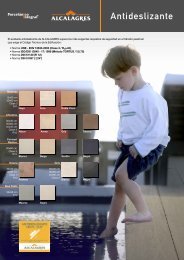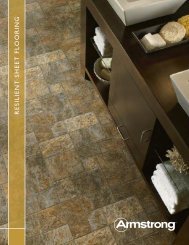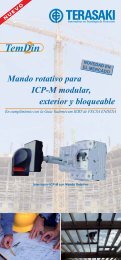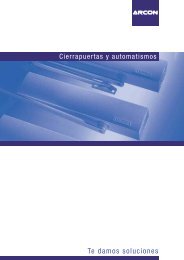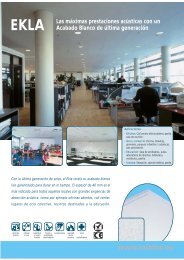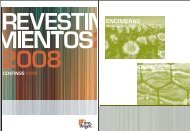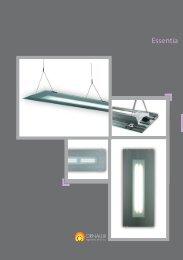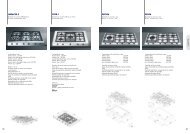loft 31,6x31,6 cm. - Habitissimo
loft 31,6x31,6 cm. - Habitissimo
loft 31,6x31,6 cm. - Habitissimo
You also want an ePaper? Increase the reach of your titles
YUMPU automatically turns print PDFs into web optimized ePapers that Google loves.
350<br />
ESPAÑOL<br />
De gran interés:<br />
Las especificaciones técnicas son<br />
válidas únicamente para los productos<br />
clasificados como primera calidad.<br />
Por ello, el incumplimiento de alguna<br />
de estas características en el resto de<br />
las clases comerciales no será causa<br />
de reclamación.<br />
Colocación<br />
El éxito del gres porcelánico se debe no sólo a la calidad técnica<br />
y estética del material, sino también a un conjunto de elementos<br />
(soporte de colocación, capas intermedias, material de agarre, juntas<br />
de dilatación…) que constituyen un verdadero sistema.<br />
baldosas cerámicas<br />
material de agarre en capa fina<br />
capas intermedias de nivelación,<br />
refuerzo y/o aislamiento<br />
capas de deslizamiento<br />
y/o aislamiento<br />
soporte del embaldosado<br />
Características del soporte<br />
Previamente a la colocación de las baldosas cerámicas, se debe<br />
estudiar el soporte sobre el que van a ser colocadas. La superficie<br />
a recubrir debe ser plana, firme y estar limpia de sustancias que<br />
puedan dificultar la adherencia del material de agarre.<br />
Las principales características a considerar en un soporte son su<br />
acabado y estado de la superficie, regularidad y planitud, capacidad<br />
de absorción de agua, deformabilidad y estabilidad dimensional,<br />
comportamiento frente al agua y a la humedad y compatibilidad<br />
química con el material de agarre a emplear.<br />
Para aquellas características que no cumplan con unos requisitos<br />
adecuados para la colocación o cuando se prevean movimientos<br />
estructurales altos, éstos deberán ser resueltos mediante el<br />
tratamiento adecuado de la superficie del soporte y/o mediante la<br />
utilización de capas de deslizamiento, de nivelación, de refuerzo y/o<br />
de aislamiento, así como un adecuado planteamiento de juntas de<br />
movimiento, cuya función es la de absorber las diferentes tensiones<br />
generadas por movimientos de soportes y estructuras.<br />
En caso de reposición sobre material cerámico ya existente, es<br />
conveniente tratar la superficie con el fin de crear puntos que<br />
faciliten la adherencia del producto.<br />
ENGLISH<br />
Highly interesting:<br />
Technical specifications are valid<br />
only for those products classified as<br />
first choice. Consequently, any failure<br />
to conform to such standards with<br />
respect to all other commercial types<br />
shall not be considered as grounds for<br />
complaint.<br />
De grand intérêt:<br />
Les spécifications techniques ne sont<br />
valables que pour les produits classés<br />
comme de première qualité.<br />
En conséquence, le non respect de l’une<br />
de ces caractéristiques dans les autres<br />
catégories commerciales ne pourra<br />
faire l’objet d’aucune réclamation.<br />
colocación y mantenimiento<br />
maintenance during building work<br />
FRANÇAIS<br />
Laying or hanging<br />
The success of porcelain tile is not only due to the technical and<br />
aesthetic quality of the material, but to a number of other factors<br />
(surface to be covered, intermediate layers, adhesive, expansion<br />
joints...) making up an entire system.<br />
ceramic tiles<br />
DEUTSCH<br />
fine adhesive layer<br />
intermediate layers for levelling,<br />
reinforcing and/or insulating<br />
non-slip and/or insulation layers<br />
surface to be tiled<br />
Features of floor or wall<br />
Von grosser Bedeutung:<br />
Die technischen Spezifikationen sind einzig<br />
für die als erste Qualität klassifizierten<br />
Produkte gültig. Folglich ist ein Nichteinhalten<br />
dieser Charakteristiken in den anderen<br />
kommerzialisierten Klassen nicht ein Motiv für<br />
Reklamationen.<br />
Prior to laying or hanging ceramic tiles, the floor or wall should be<br />
examined to ensure a stable base. The surface to be covered must be<br />
level, firm and free from substances which might prevent the adhesive<br />
from binding.<br />
The main characteristics to consider are the finish and surface<br />
condition of the floor or wall, whether it is smooth and even, its<br />
capacity for water absorbtion, deformability and dimensional stability,<br />
reaction to water and humidity and its chemical compatibility with the<br />
adhesive to be used.<br />
If the condition of the floor or wall fails to fulfil the requisites for laying<br />
or hanging, or major structural movement is foreseen, this should be<br />
solved by adequate treatment of the surface to be covered and/or using<br />
sliding layers, levelling, reinforcement and/or insulation layers and<br />
suitable provision of dilation or movement joints intended to absorb the<br />
various degrees of pressure generated by movement of the substrates<br />
and structures.<br />
In the case of recovering existing ceramic surfaces it is advisable to<br />
treat the surface in order to create areas which will help the product to<br />
adhere.<br />
ITALIANO<br />
Di grande interesse:<br />
Le indicazioni tecniche sono valide<br />
esclusivamente per i prodotti dotati di<br />
marchio di qualità superiore.<br />
Di conseguenza, il mancato rispetto di<br />
una qualunque di tali caratteristiche<br />
nelle altre categorie commerciali non<br />
potrà essere ragione di reclami.<br />
De grande interesse:<br />
As especificações técnicas são válidas<br />
unicamente para os produtos classificados<br />
como de primeira qualidade.<br />
Por conseguinte, o incumprimento de<br />
qualquer destas características nas<br />
restantes classes comerciais não deverão<br />
ser motivo de reclamação.<br />
Juntas de colocación y movimiento<br />
Es necesario el respeto escrupuloso de la junta mínima de<br />
colocación de 1,5 mm. entre baldosas, aconsejándose una anchura<br />
mayor para formatos medianos y grandes, de manera que puedan<br />
absorber las tensiones diferenciales que se produzcan en el sistema<br />
multiestrato soporte/adhesivo/baldosa.<br />
Para superficies amplias, se aconseja dividir el pavimento en<br />
sectores de 4 x 4 metros, introduciendo juntas de dilatación<br />
elásticas (juntas de partición).<br />
En cualquier caso, es aconsejable dejar una separación entre el<br />
pavimento y los elementos existentes tales como paredes, pilares<br />
y elevaciones de nivel (juntas perimetrales), cuya función es la de<br />
prevenir la acumulación de tensiones. Esta separación puede ser<br />
cubierta más tarde por el rodapié. La omisión de este tipo de juntas<br />
suele ser una de las causas más frecuentes del levantamiento del<br />
embaldosado.<br />
Características del Gres Porcelánico:<br />
técnicas de colocación y materiales<br />
de agarre<br />
Al tratarse de baldosas con muy baja capacidad de absorción de<br />
agua, es imprescindible la utilización de materiales de agarre<br />
compatibles con esa baja porosidad. La técnica de colocación<br />
adecuada es la de capa fina, con adhesivos adecuados a la<br />
porosidad abierta de la baldosa y compatibles con el soporte de<br />
colocación. En aplicaciones no residenciales es recomendable la<br />
utilización de adhesivos cementosos de alto contenido en resinas<br />
poliméricas, adhesivos en dispersión o adhesivos de reacción, según<br />
los requerimientos del soporte y las condiciones ambientales.<br />
En cualquier caso, altos niveles de adherencia, flexibilidad y buen<br />
comportamiento frente al agua pueden ser exigencias comunes, a<br />
las que habrá que agregar en aplicaciones industriales una elevada<br />
resistencia química. Este planteamiento se hace extensible a los<br />
materiales de rejuntado, para los que se exigirá habitualmente<br />
elasticidad y altas resistencias mecánicas y químicas.<br />
Para el correcto empleo del material de agarre, hay que seguir<br />
las instrucciones del fabricante del mismo modo en cuanto a<br />
preparación y aplicación, respetando los tiempos indicados.<br />
Dada la baja absorción de agua del gres porcelánico esmaltado, que<br />
retrasa el secado del material de agarre utilizado, se recomienda<br />
esperar 48-72 horas antes de hacer uso normal del pavimento.<br />
No se recomienda, en el caso de los productos pulidos, el uso de<br />
materiales de rejuntado que contengan negro de humo (carbón<br />
micronizado) ni marcar la superficie de la baldosa con lápiz, ya que<br />
su empleo podría dificultar la limpieza de la superficie revestida.<br />
PORTUGUES<br />
Placing and movement joints<br />
Strict observance of the 1.5mm minimum joint between floor tiles is<br />
essential, with a wider joint being recommended for medium and large<br />
formats, thus allowing absorption of the differential pressure produced<br />
in the multi-layer floor/adhesive/tile system.<br />
For large surface areas it is advisable to divide the floor into 4 x 4<br />
metre sections, introducing elastic expansion joints (partition joints).<br />
In any case, it is wise to leave a gap between the flooring and existing<br />
elements such as walls, pillars and raised levels (perimeter joints),<br />
intended to prevent pressure from accumulating. This gap can be<br />
covered later by the skirting tile. The absence of these joints is usually<br />
one of the most frequent causes of loose floor tiles.<br />
Features of Porcelain tile: laying or<br />
hanging techniques and adhesives<br />
Since these tiles have a very low water absorption capacity, it is<br />
essential to use adhesives compatible with low porosity. The “thin<br />
bed” laying technique should be used, with adhesives suited to<br />
the open porosity of the tile and compatible with the surface to<br />
be covered. For non-residential applications it is advisable to use<br />
cement-like adhesives with a high polymeric resin content, dispersion<br />
adhesives or reagent adhesives, depending on the floor surface<br />
requirements and the atmospheric conditions.<br />
In any case, high levels of adherence, flexibility and good resistance<br />
to water can be considered normal demands, plus high chemical<br />
resistance for industrial applications. These recommendations can<br />
also be applied to the grout, which is usually expected to be elastic<br />
and offer high mechanical and chemical resistance.<br />
To ensure a correct use of adhesives, the manufacturer’s instructions<br />
for preparation and application must always be followed, respecting<br />
the times indicated.<br />
Owing to the low water absorption of glazed gres porcelanico, which<br />
delays drying time for the adhesive being used, a 48-72 hour wait is<br />
recommended before subjecting the floor tiles to normal use.<br />
In the case of polished products, avoid using pointing materials<br />
containing soot black (micronized carbon) or making pencil markings<br />
on the surface of the tiles as this may cause difficulty when cleaning<br />
the tiled surface.<br />
• Para colocación trabada (máximo 15%) • Interlocked laying (maximum 15%)<br />
351




